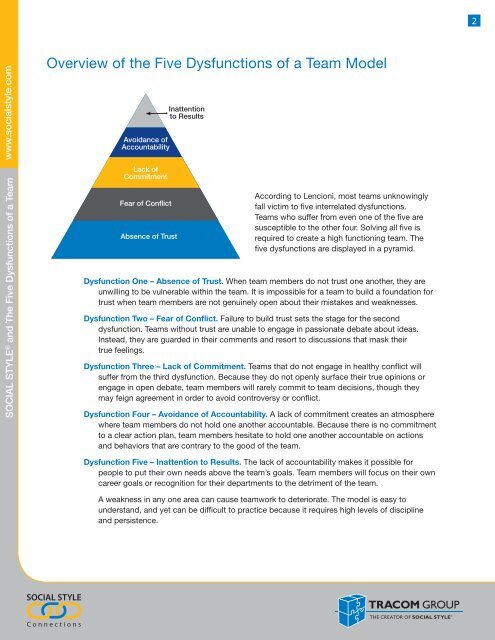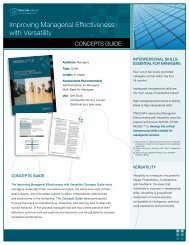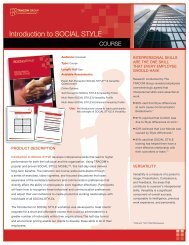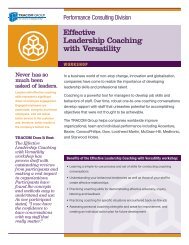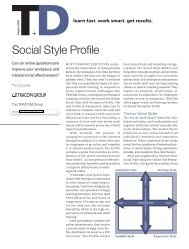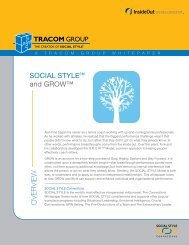Social Style and Five Dysfunctions Whitepaper - The TRACOM Group
Social Style and Five Dysfunctions Whitepaper - The TRACOM Group
Social Style and Five Dysfunctions Whitepaper - The TRACOM Group
You also want an ePaper? Increase the reach of your titles
YUMPU automatically turns print PDFs into web optimized ePapers that Google loves.
www.socialstyle.com<br />
SOCIAL STYLE ® <strong>and</strong> <strong>The</strong> <strong>Five</strong> <strong>Dysfunctions</strong> of a Team<br />
Overview of the <strong>Five</strong> <strong>Dysfunctions</strong> of a Team Model<br />
SOCIAL STYLE<br />
C onnections<br />
Avoidance of<br />
Accountability<br />
Lack of<br />
Commitment<br />
Fear of Conflict<br />
Absence of Trust<br />
Inattention<br />
to Results<br />
According to Lencioni, most teams unknowingly<br />
fall victim to five interrelated dysfunctions.<br />
Teams who suffer from even one of the five are<br />
susceptible to the other four. Solving all five is<br />
required to create a high functioning team. <strong>The</strong><br />
five dysfunctions are displayed in a pyramid.<br />
Dysfunction One – Absence of Trust. When team members do not trust one another, they are<br />
unwilling to be vulnerable within the team. It is impossible for a team to build a foundation for<br />
trust when team members are not genuinely open about their mistakes <strong>and</strong> weaknesses.<br />
Dysfunction Two – Fear of Conflict. Failure to build trust sets the stage for the second<br />
dysfunction. Teams without trust are unable to engage in passionate debate about ideas.<br />
Instead, they are guarded in their comments <strong>and</strong> resort to discussions that mask their<br />
true feelings.<br />
Dysfunction Three – Lack of Commitment. Teams that do not engage in healthy conflict will<br />
suffer from the third dysfunction. Because they do not openly surface their true opinions or<br />
engage in open debate, team members will rarely commit to team decisions, though they<br />
may feign agreement in order to avoid controversy or conflict.<br />
Dysfunction Four – Avoidance of Accountability. A lack of commitment creates an atmosphere<br />
where team members do not hold one another accountable. Because there is no commitment<br />
to a clear action plan, team members hesitate to hold one another accountable on actions<br />
<strong>and</strong> behaviors that are contrary to the good of the team.<br />
Dysfunction <strong>Five</strong> – Inattention to Results. <strong>The</strong> lack of accountability makes it possible for<br />
people to put their own needs above the team’s goals. Team members will focus on their own<br />
career goals or recognition for their departments to the detriment of the team.<br />
A weakness in any one area can cause teamwork to deteriorate. <strong>The</strong> model is easy to<br />
underst<strong>and</strong>, <strong>and</strong> yet can be difficult to practice because it requires high levels of discipline<br />
<strong>and</strong> persistence.<br />
2


